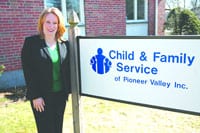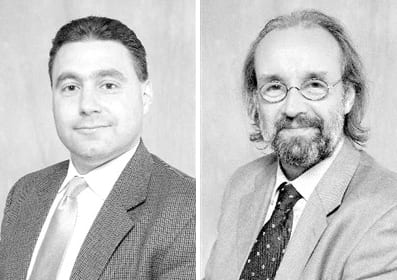Off the Charts Electronic Medical Records Pose Questions of Access, Privacy
Dr. Dirk Stanley says that, when it comes to issues like privacy and individualism, two authors have gotten deep into Americans’ heads: George Orwell and Ayn Rand.
The fact that students grow up reading 1984 and Atlas Shrugged in school isn’t the entire reason we resist a concept like a universal medical-records database, but they have contributed to the mindset that’s anxious about such a centralized system.
“A lot of countries have a national health database,” said Stanley, a hospitalist at Cooley Dickinson Hospital who also specializes in informatics. “I don’t see us selling that here in America.”
That’s going to have to change, though, because the march is on toward just that goal, starting with the conversion of all medical practices to electronic medical records (EMR) by 2015, at which time offices that are not compliant will incur fines from Medicaid.
Delcie Bean, president of Valley Computer Works in Hadley, which has recently established itself as a go-to resource on EMR issues in the region, said the government has doctors’ attention, and some are more anxious about the transition than others.
“There are two schools of thought on going electronic — actually, three. One is about those who are going after the money,” Bean said, referring to federal stimulus dollars set aside for EMR implementation, even though there are questions as to how much money will actually be available next year, when the funds are to be distributed.
“The other school of thought is that people are looking out for Medicaid penalties. They’re saying, ‘we can’t afford to be penalized,’ so they’re taking steps to avoid that,” he continued.
“The third school of thought — my favorite set of people — are those who are doing this because it’s the right thing to do, because it makes the office more efficient, reduces payroll, and makes for better record keeping and better information sharing,” Bean said. “They realize this is inevitable a few years from now, so let’s do it now, not for the stimulus money or because of Medicaid penalties, but because it’s the right thing to do.”
He understands doctors’ anxieties about tackling such a changeover in their practice, but gave more weight to the time and cost — equipment, software, consultants, training, etc. — involved in transferring patient files from paper charts to electronic data.
“The changeover will be expensive, and a lot of doctors have said, ‘I will retire before this happens,’” Bean said, noting that many physicians in the Valley, particularly in family medicine, are approaching their planned retirement age anyway, and don’t mind running out the clock before the penalties kick in. For those who plan on practicing past 2015, it’s not so easy.
“If their fears are rooted in costs, that’s legitimate,” he said. “And some doctors have been practicing the same way for 40 years, and they don’t like starting over a few years before their retirement. I understand where they’re coming from. It’s a tough transition, a big change in the way they do things.”
But the broad issue of EMR involves much more than entering data on a keyboard. Minds from medicine, government, and private enterprise are already contemplating the need for a national database — and overcoming the technological and regulatory barriers to creating one.
For one thing, the Health Insurance Portability and Accountability Act (HIPAA) is so far-reaching that it can be cumbersome even to transfer health records from one hospital to another.
And how to create a centralized database when the computer systems of different providers can’t talk to each other, and patient record numbers are completely different from facility to facility? Then there are the questions of who owns a patient’s records, and who may access them — the answers to which could reshape the way doctors and patients interact.
In other words, each potential breakthrough on the road to EMR brings another hurdle. But no one said it would be easy.
Bedside Manner
Implementing EMR will typically mean doctors carry a notebook computer into the exam room, rather than a manila folder teeming with paperwork. Some already do so, but Bean said that some also worry that typing and checking a screen during an appointment creates another barrier between the doctor and patient.
Bestselling author Dr. Pauline Chen, a liver-transplant and liver-cancer surgeon, wrote in the New York Times last month of her struggle to adapt to a new “cognitive overload” the first time she traded a physical chart for a screen.
“In order to use the computer, I had to turn my back to the patient as I spoke to him,” she wrote. “I tried to compensate by sitting on a rolling stool, but soon found myself spending more time spinning and wheeling back and forth between patient and computer than I did sitting still and listening. And when my patient did talk, his story came only in spurts, because every time I turned my back to him to type, the room fell silent.”
She’s not alone in her worry. The Center for Studying Health System Change, a health-policy research organization based in Washington, D.C., released a lengthy report on the effects of EMR on physician-patient communication.
One physician in the report said the computer is “like having a 2-year old in the room,” while another observed that “there are a lot of gadgets and gizmos and that can pull us away from our objective.”
According to the report, EMRs have enabled some clinicians to engage less with patients because so much more information is available before actually seeing the patient. As one internist fretted, “a lot of us feel like we’re already seeing it. One of the hospitalists yesterday said, ‘this is great. I used the EMR before I came here. I was able to sit down with my bagel and coffee and do my rounds before I even got in.’”
However, although the wealth of information in a computer record can lull physicians into believing they have all the information, causing them to communicate less with the patient, the report noted, that tendency can be overcome, and mitigated by benefits such as being able to pull up relevant information quickly to enhance a discussion, or to order tests without having to leave the room to call an assistant, causing less disruption to the patient visit.
And some EMR users cited several ways to avoid diminishing interpersonal communication with patients. Several noted that showing patients portions of their records could facilitate more accurate documentation and joint decision making, while helping to avoid a sense of alienation for patients while the physician looks at the computer screen.
“Many of the potential pitfalls of electronic records,” Chen wrote, “can be avoided if doctors and other clinicians are taught how to use the software efficiently and how to communicate effectively with patients when using it.”
Broken Records
Still, when doctors talk about the wealth of information that could be available at their fingertips through EMR, patients have to wonder how much of it is accurate.
As an example, Stanley brought up Dave deBronkart, a prominent health blogger who’s known online as e-Patient Dave. Through his own experience beating stage IV kidney cancer, he became an advocate for a model of health care where information is shared more freely between doctors and patients.
His story is compelling. Early in 2007, a routine X-ray showed a shadow in deBronkart’s lung, which turned out to be metastasized kidney cancer. After his doctor gave him 24 weeks to live, he dove headlong into the Internet, researching information about his condition, joining an expert patient community, and starting an online journal to share his experience. Doctors at Beth Israel Deaconess Medical Center in Boston eventually helped him beat the cancer, but he remained an active part of the online communities he had established.
Last year, deBronkart opted to have his personal health records transferred onto Google Health, one of the leading personal health record systems available today. What he found shocked him: the data contained a slew of incorrect information, such as a false medication warning, exaggerated diagnoses, and conditions he’d never had. To make matters worse, the system failed to transfer important information such as lab results and allergies.
The problem was that the hospital transferred insurance billing codes, not clinical data, and those codes sometimes reflect imprecise information.
That fact is discouraging for those, including some in the Obama administration, who are pushing to computerize all medical records within five years. Insurance data, already computerized, is easier and cheaper to download, but it’s prone to inaccuracies. On the other hand, transferring each bit of information from paper charts or outdated computer drives could take much longer, at much greater cost, than first anticipated.
As for deBronkart, he has become a fierce advocate for patients having access to their records — the law is on the patient’s side, he notes — and he supports the push toward nationalized EMR, but with a caveat.
“I was glad [my experience] did get the attention,” deBronkart wrote on his blog, epatientdave.com, “because I work with data in my day job and I know the value of good quality data, well-managed — and it was easy to see that this data transfer didn’t fit that standard. I believe we have a long way to go before health IT catches up with the kind of IT best practices found in other industries.”
Then there’s the question of whether patients are equipped to understand what’s in their chart.
Stanley cited a personal example — that of his father, who was diagnosed with an aortic aneurism of 5 cm, and read online that anything more could be fatal, so he worried excessively leading up to a procedure to correct it.
“Now, I’ve seen hundreds of these,” Stanley said, and knew that the condition was not likely to worsen, but patients don’t have that depth of knowledge and context.
Now multiply that experience by every patient a doctor sees in an average day. He concedes that, if patients start to access their own records regularly, they’ll focus like a laser on some screening level that seems out of whack, not realizing that every healthy person has some reading that’s not quite the norm. And doctors will have to spend valuable time explaining that number — and visits will take more time.
That’s a problem. It’s not that doctors don’t want to spend time with patients, but the way they’re currently reimbursed almost requires them to get as many patients in and out as possible.
In other words, Stanley said, the payment structure might have to change if patients start seeing their charts and requiring more ‘reassurance time’ with doctors — not to mention the temptation to keep certain information out of a patient’s chart, and the legal implications of doing so. “All the education that will be necessary … it’s going to be a real challenge.”
Square One
Meanwhile, Bean continues to prepare doctors for the coming changes, running seminars several times a year to help physicians understand what they need to start doing right now to be in compliance. The questions raised surrounding EMR may be sticky, but he’s optimistic.
“It’s a dramatic shift in the way they’re trained — there’s more transparency, for one thing,” he said. “But there are some exciting benefits, too. We’re just trying to give doctors the confidence to go forward.”



